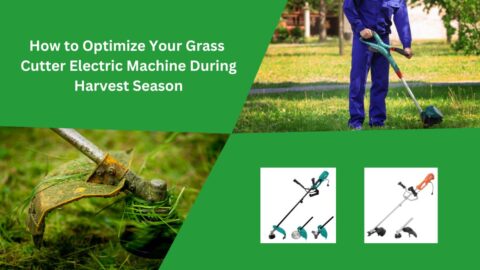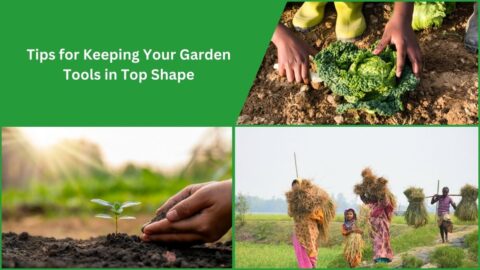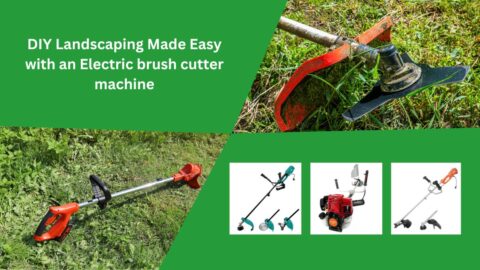Just as an artist meticulously prepares their canvas, farmers and gardeners must carefully prepare their land before planting. This crucial step creates the optimal environment for seeds to thrive. Skip it, and you risk stunted growth, poor yields, and plenty of frustration. So, let’s dig into the essential steps that set the stage for planting success.
How do Farmers Prepare the Soil for Planting?
Farmers use a variety of techniques tailored to their specific crops and land conditions. Here are the most common practices:
Clearing the Land
The first step is to remove unwanted vegetation, rocks, debris, and weeds. This gives new plants clear access to sunlight, water, and nutrients. On large-scale farms, machines like tractors with mowers or cultivators get the job done. For smaller plots or for cutting through tough weeds and overgrowth, tools like an Electric brush cutter machine can be especially effective and time-saving.
Tilling or Plowing
Tilling breaks up compacted soil, enhances aeration, and improves drainage. Depending on the soil type and crops, farmers choose from shallow tilling to deep plowing. Root crops like carrots and potatoes especially benefit from deeper, looser soil.
Soil Testing
Often overlooked, soil testing is vital. It reveals pH levels and nutrient content like nitrogen, phosphorus, and potassium. With these insights, farmers can fine-tune their soil amendments. Local agricultural offices or soil testing labs can provide these services.
Adding Soil Amendments
Amendments are added to enrich the soil and enhance its texture and water retention. Common amendments include:
- Organic Matter: Compost, manure, or cover crops that supply nutrients and improve structure.
- Lime: Raises pH in acidic soils.
- Sulfur: Lowers pH in alkaline soils.
- Fertilizers: Deliver targeted nutrients. Farmers apply the right amount to avoid nutrient imbalances or runoff.
Creating Planting Beds or Rows
Raised beds can boost drainage and soil temperature, especially useful in heavy clay or cooler climates. Rows, on the other hand, make planting, weeding, and harvesting more manageable. Many farmers also buy grass cutting machine tools to maintain pathways and spaces between rows efficiently.
Leveling and Smoothing
A flat, even surface ensures consistent planting depth and water distribution. It’s a simple yet important step for uniform growth.
Land Preparation for the Vegetable Garden
Home gardeners can adopt the same principles as farmers, scaled down to fit backyard plots. Here’s how to prepare your vegetable garden for success:
Clear the Area
Remove grass, weeds, rocks, and debris manually using a spade or hoe. To deal with stubborn weeds, cover the area with black plastic for a few weeks to block sunlight and kill them off.
Dig or Till the Soil
Loosen the soil to a depth of 8–12 inches using a garden fork or mini tiller. This boosts aeration and allows roots to grow deep and strong.
Test Your Soil
Use a DIY test kit or send a sample to a local extension office. Knowing your soil’s pH and nutrient levels helps guide decisions on amendments.
Amend the Soil
Based on your soil test results, work in necessary amendments. Compost is a universal booster, adding nutrients and improving soil structure. Mix amendments into the top 4–6 inches of soil.
Consider Raised Beds
If drainage is a challenge or you want to warm the soil faster in spring, raised beds are ideal. Use wood, bricks, or other materials and fill with quality garden soil.
Create Planting Rows or Beds
Use a rake to level the soil. For rows, make shallow furrows with a hoe. For wider beds, ensure the surface is even for proper seed placement and water flow.
Water Lightly
Once the soil is prepared, lightly water it. This helps settle the soil and ensures adequate moisture levels for seeds to germinate.
Tips on Land Preparation for Planting
Here are a few extra tips to maximize your land preparation efforts:
- Timing is Key: Start a few weeks before planting to give amendments time to work and allow the soil to settle.
- Don’t Overwork the Soil: Excessive tilling can destroy soil structure and kill beneficial microbes. Disturb the soil only as much as needed.
- Consider No-Till Methods: Especially in established gardens, no-till methods preserve soil health. Simply layer compost and organic matter on top of the soil.
- Incorporate Cover Crops: Grow cover crops like clover or buckwheat during the off-season to enrich soil, prevent erosion, and suppress weeds. Till them back in as green manure.
- Observe Your Soil: Pay close attention to how your soil feels, drains, and reacts to moisture. These observations help you refine your techniques over time.
Also, as you prepare your garden or farm, it’s helpful to research the latest equipment. Understanding the brush cutter price or comparing various brush cutter machine price options ensures you’re investing in tools that suit your needs and budget.
Preparing the soil isn’t just about digging dirt, it’s about setting the stage for growth. With time, care, and a bit of knowledge, your land will reward you with lush plants and generous harvests. Because in the world of gardening and farming, the most important work often happens before the first seed is ever planted.
FAQ
Q1. What is the most ideal method of land preparation?
One of the oldest and most common methods of land preparation is plowing. This involves using a plow to turn over and loosen the soil, creating a fresh bed for seeds or seedlings. Plowing is particularly effective in breaking up compacted soil, allowing for better water infiltration, root growth, and nutrient uptake.
Q2. What is the first thing to do before planting?
Get to know your soil
All you have to do is dig up a small patch in the area where you want to plant your garden. You’ll want to see if your soil is sandy, mostly made of clay or if it’s rich and dark.










